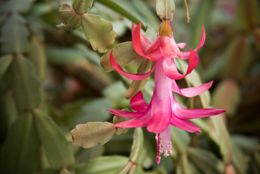The Christmas cactus lights up the face of anyone who beholds it. It is a very pretty gift too; but, you must know how to take proper care of this delicate cactus. Here are a few tips.

Christmas cacti are quite unlike the thorny xerophytic cacti that we are so very familiar with. In fact, These cacti can have very pretty flowers exactly at Christmas time, provided they have been well-cared for. Having a cactus plant in full bloom during the festive season is a great big challenge in itself. But, if you have a proper blossoming Christmas cactus in your home when the season comes, it is one of the most fulfilling things to have around.
The common complaint with Christmas cacti is that they do not flower when expected, i.e. during the Christmas season. If that is happening with your cactus, then something is certainly going wrong. Here, I discuss some of the common problems that can happen with the upkeep of the cactus plant.
The Christmas Cactus
For the botanically inclined people, Christmas cactus is
Schlumbergera bridgesii, and it belongs to the family of holiday cacti, which also includes the Thanksgiving cactus and the Easter cactus. All these cacti are named after the seasons in which they bring forth their blossoms. The cactus has mainly pink blossoms, though there are varieties that have white, red and violet blossoms too. This is a tropical plant, and it does require water. The plant is usually found in nature in areas where orchids are found. Brazil is the place of origin of this unique plant.
Christmas Cactus Care
There are several things you need to know and follow in order to have the cactus blossoming at the right time. Now here are some reasons why your cactus may not bloom at the right time. If you try to get rid of these causes, your cactus plant will blossom at the right time.
- There are some optimum temperature conditions that you have to maintain for your cactus to bloom. These plants love the cool climate. So you must make sure not to keep these plants in the warm regions of your home, such as close to the heater vents, in direct contact of sunlight, etc. A temperature of 61-70 °F in the daytime and 56-65 degree F in the nighttime will do well for the plant to ensure that it blooms nicely.
- This plant also has some requirements for light conditions. You need to keep this plant for 12-13 hours in complete darkness from September onward. If you do so, then the plant will show its blossoms when December arrives. At the same time, keeping the plant in indirect sunlight for a couple of hours every day will bring out better blossoms.
- Being a tropical plant, the cactus does require water regularly. You have to make sure the plant is given water whenever it becomes dry to the touch. But, you should also bear in mind that the water is well-drained off. Christmas cacti will not bloom if they are kept in pots where water often gets clogged. The secret to a healthy cactus is keeping it in a well-watered and well-drained pot.
- This plant will also require fertilizers. However, fertilizers are not required when the plant is dormant. But, when it is nearing its blooming time, you will need to provide it with a houseplant fertilizer twice a month. Interestingly, these plants are not prone to pests infestation and diseases.
Christmas cacti are used to enliven Christmastime decorations. These plants have colorful blossoms, and hence, do not need to be adorned with any other decoration. But the cactus must be placed in creative ways to accentuate its beauty. Since the cactus has large pendulous leaves with flowers blossoming at the ends of the stems, one good idea is to keep the plant in a hanging pot.
A blossomed Christmas cactus is considered to be a lovely gift to give during the festive season. The plant usually keeps blossoming right up to March, with their blossoms peaking in the month of January. That is the reason, if you give this plant to someone as a gift during Christmas, they can enjoy the blossoms for a couple of months in the New Year. However, you must tell them in advance that the cactus would become dormant around February end, and then will rebloom in the next December. So, just take a look at the fully blossomed cactus, and you are sure to be mesmerized!






 Christmas cacti are quite unlike the thorny xerophytic cacti that we are so very familiar with. In fact, These cacti can have very pretty flowers exactly at Christmas time, provided they have been well-cared for. Having a cactus plant in full bloom during the festive season is a great big challenge in itself. But, if you have a proper blossoming Christmas cactus in your home when the season comes, it is one of the most fulfilling things to have around.
Christmas cacti are quite unlike the thorny xerophytic cacti that we are so very familiar with. In fact, These cacti can have very pretty flowers exactly at Christmas time, provided they have been well-cared for. Having a cactus plant in full bloom during the festive season is a great big challenge in itself. But, if you have a proper blossoming Christmas cactus in your home when the season comes, it is one of the most fulfilling things to have around.